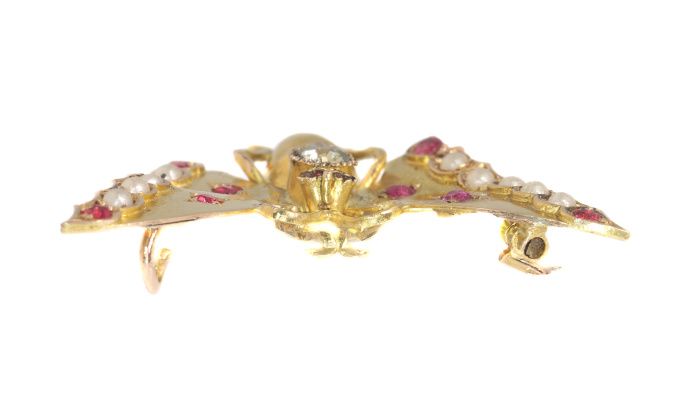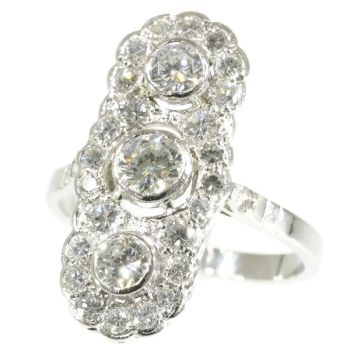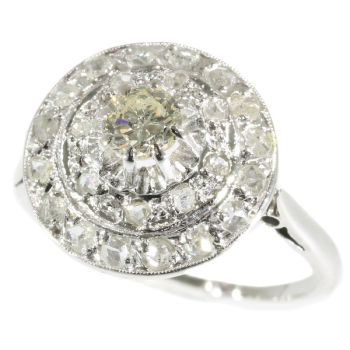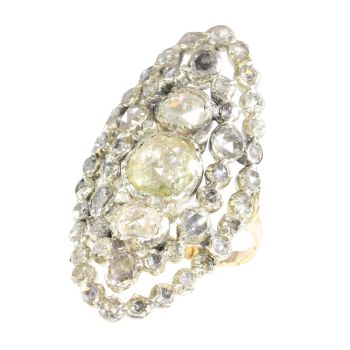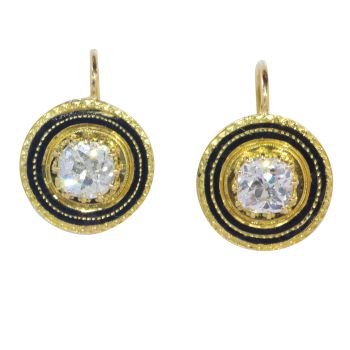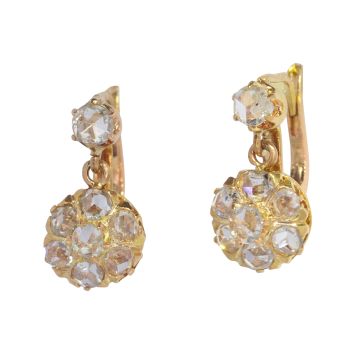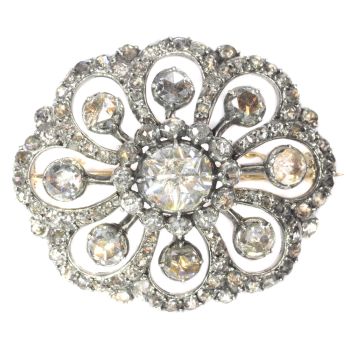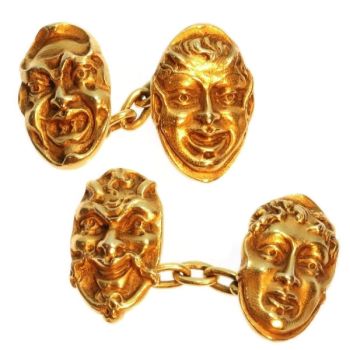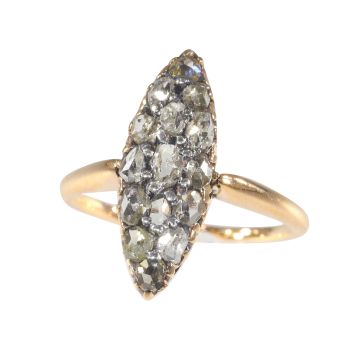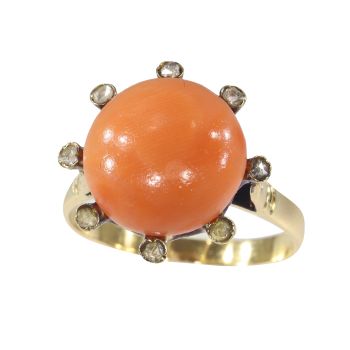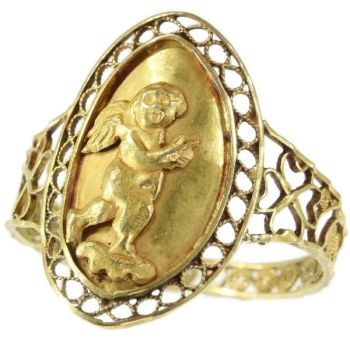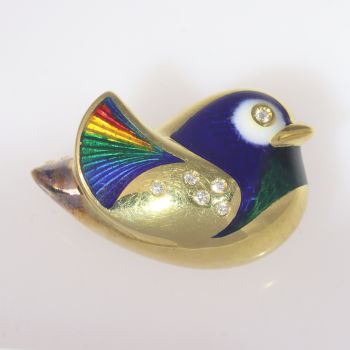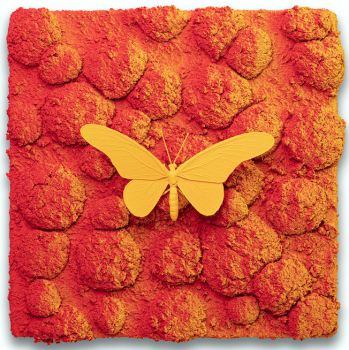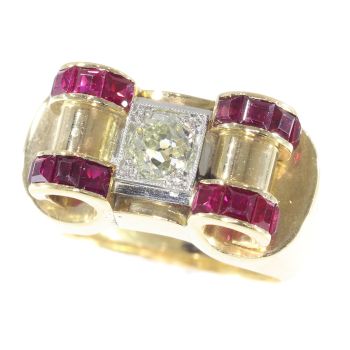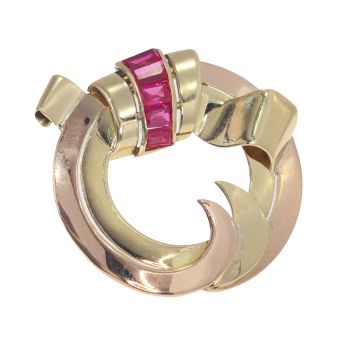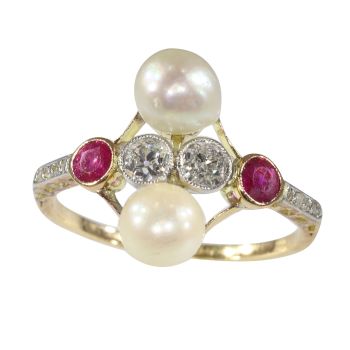Antiek gouden Victoriaanse vlinderbroche 1890
Onbekende Kunstenaar
Adin Fine Antique Jewellery
- Over kunstwerk
Antique jewelry object group: brooch
Condition: very good condition
- (more info on our condition scale)
Country of origin: unknown
Style: Victorian - Victorian decorative arts refers to the style of decorative arts during the Victorian era. The Victorian era is known for its eclectic revival and interpretation of historic styles and the introduction of cross-cultural influences from themiddle east and Asia in furniture, fittings, and Interior decoration. Victorian design is widely viewed as having indulged in a regrettable excess of ornament. The Arts and Crafts movement, the aesthetic movement, Anglo-Japanese style, and Art Nouveaustyle have their beginnings in the late Victorian era.
- See also: Victorianor more info on styles
Style specifics: The Late or Aesthetic Victorian Period - Experts divide the reign of Queen Victoria, also called The Victorian era (1837-1901) into three periods of about twenty years each; The Romantic Victorian Period (1837 - 1860), The Grand Victorian Period(1860 - 1880), and the Late or Aesthetic Victorian Period (1880 - 1901).
We consider this to be of The Late or Aesthetic Victorian Period.
Jewelry of this period is changing back from heavy to more smaller, romantic pieces with often whimsical motifs. Jewelers using diamonds and bright gemstones in elaborated and fine feminine pieces.
Period: ca. 1890
- (events & facts of this era, poetry of this era, fashion of this era)
Source of inspiration: Mother Nature
Theme: butterfly
Material: 18K yellow gold (touchstone tested)
- (more info on precious metals)
Extra information: Butterfly - Artistic depictions of butterflies have been used in many cultures including Egyptian hieroglyphs 3500 years ago. In the ancient Mesoamerican city of Teotihuacan, the brilliantly colored image of the butterfly was carved into many temples,buildings, jewelry, and emblazoned on incense burners in particular. Today, butterflies are widely used in various objects of art and jewelry: mounted in frames, embedded in resin, displayed in bottles, laminated in paper, and used in some mixed mediaartworks and furnishings. Butterfly symbolism - A butterfly was seen in Japan as the personification of a person's soul; whether they be living, dying, or already dead. One Japanese superstition says that if a butterfly enters your guestroom and perches behind the bamboo screen, the person whom you most love is coming to see you. The Russian word for "butterfly", bábochka, also means "bow tie". It is a diminutive of "baba" or "babka" (= "woman, grandmother, cake"), whence also "babushka" = "grandmother". The ancient Greek word for "butterfly" is psyche, which primarily means "soul" or "mind". According to Mircea Eliade's Encyclopedia of Religion, some of the Nagas of Manipur trace their ancestry from a butterfly. In Chinese culture, two butterfliesflying together symbolize love. Also, Butterfly Lovers is a famous Chinese folktale. In some old cultures, butterflies also symbolize rebirth after being inside a cocoon for a period of time. Some people say that when a butterfly lands on you it meansgood luck. The idiom "butterflies in the stomach" is used to describe a state of nervousness. (From Wikipedia) Cartier - A leading French jewelry firm, founded in 1847 by Louis-Francois Cartier (1819-1904).
Its headquarters are in Paris, with branches in several major centres. The founder was joined in 1872 by his son Alfred (1836-1925), and the latter, with his eldest son, Louis (1875-1942), moved the Paris business in 1898 to its present address, 13 Ruede la Paix.
In 1902 Alfred's second son, Pierre (1878-1964), opened a branch in London and in 1903 in New York City. In 1909 the London branch was taken over by-the youngest brother Jacques (1885-1942), by which time it had moved to its present address at 175 NewBond St.
A group headed by Robert Hocq (1917-79)acquired from the Cartier family the branches in Paris (1972), London (1974), and New York (1976). Hocq was Managing Director until his death when he was succeeded by his daughter, Nathalie (b. 1951),who since 1974had headed the high-fashion jewelry department and promoted the boutique collection of jewelry known as Les Musts'.
Originally the firm made jewelry of enameled gold set with gemstones, which attracted a prestigious clientele, including French royalty and the future Edward VII;in recent years it has greatly expanded into new types and styles of jewelry, and isextending its world-wide operations.
Diamond(s): One old European cut diamond with an estimated weight of ± 0.17ct. (colour and clarity: K/M, i).
- All diamond weights, color grades and clarity are approximate since stones are not removed from their mounts topreserve the integrity of the setting. Also we have all diamonds screened by the IJGC - lab (www.ijgc-worldwide.com)for whether they are natural or synthetic, and all diamonds in this jewel are 100% guaranteed to be natural!
Precious stones: Tenred strass (also called paste) as ruby imitation and ten half seed stone pearls
- All color stone weights are approximate since stones are not removed from their mounts to preserve the integrity of the setting.
Birthstones: Diamond is the birthstone (or month stone) for April, ruby for July and pearl for June.
- (more info on birthstones)
Hallmarks: No trace.
- (more info on hallmarks)
Dimensions: 3,34 cm (1,31 inch) x 2,60 cm (1,02 inch) - See picture with a ruler in cm and inches
Weight: 3,40 gram (2,19 dwt)
Adin Reference Nº: 20188-0099
Copyright photography: Adin, fine antique jewellery
jewelry with insects, yellow gold jewelry, jewelry with diamond, jewelry with strass/paste, jewelry with pearls, latest acquisitions,
antique jewelry, estate jewelry, vintage jewelry or modern jewelry
Jewelry with birthstones (or month stones) for:
January - February - March - April - May - June - July
August - September - October - November or December.
Additional information:
jewelry glossary - wall of fame - visit us in Antwerp - subscribe to our mailinglist.
What is antique jewelry? - What is estate jewelry? - What is vintage jewelry?
- Over kunstenaar
Het kan voorkomen dat een kunstenaar of maker onbekend is.
Voor sommige werken is het niet te bepalen door wie het gemaakt is of dat het is gemaakt door (een groep) ambachtslieden. Voorbeelden zijn beelden uit de Oudheid, meubels, spiegels of handtekeningen die vaak niet duidelijk of leesbaar zijn. Maar ook sommige werken zijn helemaal niet gesigneerd.
Ook kunt u de volgende beschrijving vinden:
•"Toegeschreven aan …." waarschijnlijk een werk van de kunstenaar maar niet zeker of gedeeltelijk
•“Atelier van ….” of werkplaats van” een werk uitgevoerd in het atelier of atelier van de kunstenaar, eventueel onder zijn toezicht
•“Cirkel van ….” een werk uit de periode van de kunstenaar die zijn invloed laat zien, nauw verbonden met de kunstenaar maar niet noodzakelijkerwijs zijn leerling
•“Stijl van ….” of “Volger van ….” een werk uitgevoerd in de stijl van de kunstenaar, maar niet noodzakelijk door een leerling; kan eigentijds of bijna eigentijds zijn
•“Wijze van ….” een werk in de stijl van de kunstenaar maar van latere datum
•"Na …." een kopie (van welke datum dan ook) van een werk van de kunstenaar
•“Getekend…”, “Gedateerd….” of “Ingeschreven” dan is het werk gesigneerd/ gedateerd/ ingeschreven door de kunstenaar. De toevoeging van een vraagteken duidt op een element van twijfel
•"Met handtekening ...", "Met datum ...", "Met opschrift..." of “Draagt signatuur/datum/opschrift” dan is de handtekening/datum/opschrift toegevoegd door iemand anders dan de kunstenaar
Bent u geïnteresseerd om dit kunstwerk te kopen?
Artwork details
Related artworks
- 1 - 4 / 12
- 1 - 4 / 24
Onbekende Kunstenaar
Enchanting 1870s Vintage Fly Brooch: Victorian Elegance in Gold1870
€ 4.600Adin Fine Antique Jewellery
 Gecureerd door
Gecureerd doorDanny Bree
1 - 4 / 24Samuel Dejong
Anatomia Blue heritage II Goliath Beetle closed BGG2019
Prijs op aanvraagVilla del Arte Galleries
1 - 4 / 24Onbekende Kunstenaar
Enchanting 1870s Vintage Fly Brooch: Victorian Elegance in Gold1870
€ 4.600Adin Fine Antique Jewellery
 Gecureerd door
Gecureerd doorDanny Bree
1 - 4 / 24- 1 - 4 / 12







